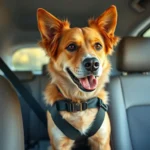
Service dogs play a vital role in the lives of many individuals with disabilities, providing assistance that enables them to navigate daily challenges. However, the question often arises: can a Pitbull be a service dog? This inquiry is not just about the capabilities of the breed but also delves into the misconceptions surrounding Pitbulls and their suitability for such an important role.
As we explore this topic, we will clarify the qualifications, training, and regulations regarding service dogs, focusing on whether Pitbulls can meet these standards.
Understanding Service Dogs
Definition of Service Dogs
Service dogs are specially trained to perform specific tasks that assist individuals with disabilities. It is essential to differentiate them from therapy dogs and emotional support animals. According to the Americans with Disabilities Act (ADA), a service dog is defined as a dog that has been individually trained to perform tasks for a person with a disability. This can include guiding the visually impaired, alerting individuals with hearing impairments, pulling a wheelchair, and even alerting or protecting a person experiencing a seizure.
Roles and Responsibilities of Service Dogs
The tasks performed by service dogs are varied, depending on the needs of their handlers. Some common examples include:
- Guiding individuals who are visually impaired.
- Alerting those with hearing impairments to sounds.
- Detecting medical conditions such as diabetes or seizures.
- Providing stability for individuals with mobility challenges.
Each service dog must undergo rigorous, task-specific training to ensure they can perform their duties effectively. This training is crucial, as the dog’s ability to respond to commands and behave appropriately in public settings can significantly impact their handler’s independence and safety.
The Pitbull Breed
Overview of the Pitbull Breed
Pitbulls, often characterized by their muscular build and strong jaws, have a history that dates back to the early 19th century when they were bred for bull-baiting and farm work. Over time, they have evolved into loyal companions known for their intelligence, strength, and unwavering loyalty. Despite their tough exterior, many Pitbulls are affectionate and eager to please.
Addressing Misconceptions
Pitbulls often face stigma and negative stereotypes, primarily due to media portrayal and incidents involving irresponsible ownership. However, statistics reveal that behavior and temperament are more closely related to an individual dog’s upbringing and training rather than the breed itself. In fact, many studies indicate that Pitbulls are no more aggressive than other breeds when properly trained and socialized. This underscores the importance of evaluating individual dogs rather than making blanket assumptions based on breed.
Can Pitbulls Be Trained as Service Dogs?
Temperament Requirements
To qualify as a service dog, a dog must possess specific temperament traits, including calmness, confidence, and the ability to focus on tasks despite distractions. Pitbulls can meet these standards, as many exhibit a keen desire to work and a strong bond with their handlers. It’s crucial to consider the individual personality of each dog rather than solely their breed.
Training Considerations
Training a Pitbull as a service dog involves several key components:
- Positive Reinforcement: Utilizing motivational techniques to encourage desired behaviors.
- Early Socialization: Exposing puppies to various environments, people, and other animals to develop well-rounded temperaments.
- Obedience Training: Teaching basic commands (sit, stay, come) is foundational before moving on to task-specific training.
While some Pitbulls may face challenges due to their strong-willed nature, patience and consistency in training can lead to successful outcomes. Identifying potential issues early and addressing them with appropriate training methods can create a positive experience for both the dog and the handler.
Legal Considerations
ADA Regulations Regarding Service Dogs
The ADA provides clear guidelines regarding service dogs, stating that they are defined as dogs specifically trained to assist individuals with disabilities. Importantly, the ADA does not impose breed restrictions, meaning that a Pitbull can be a service dog just as effectively as any other breed. However, it is essential for service dog handlers to understand that their dogs must be trained to perform tasks that directly relate to their disabilities.
State and Local Laws
While the ADA sets the federal standard, state and local laws may vary regarding service dog regulations and breed restrictions. Some areas might impose specific limitations on certain breeds, including Pitbulls. Therefore, it is crucial for potential handlers to check local regulations to ensure compliance and to understand their rights.
Success Stories of Pitbull Service Dogs
Case Studies
There are numerous instances of Pitbulls excelling as service dogs, demonstrating their capabilities and dispelling myths. For example, a Pitbull named Luna assists her owner, who has PTSD, by providing emotional support during anxiety attacks and reminding her to take medication. Another example is Buster, a Pitbull trained to alert his owner to impending seizures, significantly improving her quality of life.
These success stories highlight the incredible bond between Pitbulls and their handlers, showcasing the diverse tasks they can perform and the positive impact they have.
Community Perception
The success of Pitbull service dogs can help shift community perceptions. By sharing these stories, advocates promote awareness about responsible ownership and the potential of this breed. Advocacy groups play a vital role in supporting these efforts, highlighting the benefits of service dogs and working to change negative stereotypes.
How to Train a Pitbull as a Service Dog
Finding a Qualified Trainer
When considering training a Pitbull as a service dog, it is crucial to find a qualified trainer experienced in service dog training. Look for trainers who utilize positive reinforcement methods and have a good reputation in the community. Organizations specializing in service dog training can be excellent resources for finding reputable trainers and programs.
Training Steps Overview
Training a Pitbull as a service dog typically involves several steps:
- Basic Commands: Start with foundational commands like sit, stay, and come.
- Socialization: Introduce the dog to various environments, people, and other animals.
- Task-Specific Training: Depending on the handler’s needs, train the dog to perform specific tasks.
- Public Access Training: Teach the dog how to behave appropriately in public settings.
Ongoing training and reinforcement are essential. Regular practice helps maintain the dog’s skills and ensures they remain focused and well-behaved in various situations.
Conclusion
In summary, the question of can a Pitbull be a service dog is answered affirmatively when considering individual temperament and training. Despite the stigma surrounding the breed, many Pitbulls possess the qualities necessary to excel as service dogs. With proper training, socialization, and a commitment from their handlers, Pitbulls can provide invaluable support to those in need.
As we continue to advocate for responsible ownership and awareness, it is essential to recognize the potential of Pitbulls as service dogs and to challenge the misconceptions that often overshadow them. By focusing on the individual qualities of each dog, we can pave the way for a more inclusive understanding of what makes a successful service animal.









